Longest Consecutive Sequence in an Array
Given an array nums of n integers, return the length of the longest sequence of consecutive integers. The integers in this sequence can appear in any order.
Examples:
Input: nums = [100, 4, 200, 1, 3, 2]
Output: 4
Explanation: The longest sequence of consecutive elements in the array is [1, 2, 3, 4], which has a length of 4. This sequence can be formed regardless of the initial order of the elements in the array.
Input: nums = [0, 3, 7, 2, 5, 8, 4, 6, 0, 1]
Output: 9
Explanation: The longest sequence of consecutive elements in the array is [0, 1, 2, 3, 4, 5, 6, 7, 8], which has a length of 9.
Input: nums = [1, 9, 3, 10, 4, 20, 2]
Constraints
- 1 <= nums.length <= 105
- -109 <= nums[i] <= 109
Hints
- Use a hash set to store all elements of the array. Iterate through the array, and for each element, check if it is the start of a sequence by ensuring that num−1 is not in the set.
- For each starting number, count the length of the consecutive sequence by checking for num+1, num+2, etc., in the set. Maintain a variable to store the length of the longest sequence encountered during the traversal.
Company Tags
Editorial
Intuition
One simple approach is to look for sequences of consecutive numbers by utilising linear search in the array. For each number 𝑥 in the array, we'll check if the next numbers like 𝑥+1, 𝑥+2, 𝑥+3, and so on, are also in the array. This is like checking if we can build a chain of numbers that follow each other directly. By doing this for every number in the array, we can find the longest chain of consecutive numbers. Finally, we'll find the length of the longest chain among all the numbers in the array.
Approach
- As you iterate through each number in the array, begin by checking if consecutive numbers like ( x+1, x+2, x+3 ), and so on, exist in the array. The occurrence of the next consecutive number can be checked by using linear search.
- When you find consecutive numbers, start counting them using a counter. Increment this counter each time you find the next consecutive number in the sequence.
- This counter effectively keeps track of how long the current consecutive sequence is as you move through the array and find more consecutive numbers.
Dry Run:-Please refer to the video for the dry-run.
#include <bits/stdc++.h>
using namespace std;
class Solution {
private:
// Helper function to perform linear search
bool linearSearch(vector<int>& a, int num) {
int n = a.size();
// Traverse through the array
for (int i = 0; i < n; i++) {
if (a[i] == num)
return true;
}
return false;
}
public:
// Function to find the longest consecutive sequence
int longestConsecutive(vector<int>& nums) {
// If the array is empty
if (nums.size() == 0) {
return 0;
}
int n = nums.size();
// Initialize the longest sequence length
int longest = 1;
// Iterate through each element in the array
for (int i = 0; i < n; i++) {
// Current element
int x = nums[i];
// Count of the current sequence
int cnt = 1;
// Search for consecutive numbers
while (linearSearch(nums, x + 1) == true) {
// Move to the next number in the sequence
x += 1;
// Increment the count of the sequence
cnt += 1;
}
// Update the longest sequence length found so far
longest = max(longest, cnt);
}
return longest;
}
};
int main() {
vector<int> a = {100, 4, 200, 1, 3, 2};
// Create an instance of the Solution class
Solution solution;
// Function call for longest consecutive sequence
int ans = solution.longestConsecutive(a);
cout << "The longest consecutive sequence is " << ans << "\n";
return 0;
}
import java.util.*;
class Solution {
// Helper function to perform linear search
private boolean linearSearch(int[] a, int num) {
int n = a.length;
// Traverse through the array
for (int i = 0; i < n; i++) {
if (a[i] == num)
return true;
}
return false;
}
public int longestConsecutive(int[] nums) {
// If the array is empty
if (nums.length == 0) {
return 0;
}
int n = nums.length;
// Initialize the longest sequence length
int longest = 1;
// Iterate through each element in the array
for (int i = 0; i < n; i++) {
// Current element
int x = nums[i];
// Count of the current sequence
int cnt = 1;
// Search for consecutive numbers
while (linearSearch(nums, x + 1) == true) {
// Move to the next number in the sequence
x += 1;
// Increment the count of the sequence
cnt += 1;
}
// Update the longest sequence length found so far
longest = Math.max(longest, cnt);
}
return longest;
}
public static void main(String[] args) {
int[] a = {100, 4, 200, 1, 3, 2};
// Create an instance of the Solution class
Solution solution = new Solution();
// Function call for longest consecutive sequence
int ans = solution.longestConsecutive(a);
System.out.println("The longest consecutive sequence is " + ans);
}
}
class Solution:
# Helper function to perform linear search
def linearSearch(self, nums, num):
n = len(nums)
# Traverse through the array
for i in range(n):
if nums[i] == num:
return True
return False
def longestConsecutive(self, nums):
# If the array is empty
if len(nums) == 0:
return 0
n = len(nums)
# Initialize the longest sequence length
longest = 1
# Iterate through each element in the array
for i in range(n):
# Current element
x = nums[i]
# Count of the current sequence
cnt = 1
# Search for consecutive numbers
while self.linearSearch(nums, x + 1):
# Move to the next number in the sequence
x += 1
# Increment the count of the sequence
cnt += 1
# Update the longest sequence length found so far
longest = max(longest, cnt)
return longest
if __name__ == "__main__":
a = [100, 4, 200, 1, 3, 2]
# Create an instance of the Solution class
solution = Solution()
# Function call for longest consecutive sequence
ans = solution.longestConsecutive(a)
print("The longest consecutive sequence is", ans)
class Solution {
// Helper function to perform linear search
linearSearch(nums, num) {
const n = nums.length;
// Traverse through the array
for (let i = 0; i < n; i++) {
if (nums[i] === num)
return true;
}
return false;
}
longestConsecutive(nums) {
// If the array is empty
if (nums.length === 0) {
return 0;
}
const n = nums.length;
// Initialize the longest sequence length
let longest = 1;
// Iterate through each element in the array
for (let i = 0; i < n; i++) {
// Current element
let x = nums[i];
// Count of the current sequence
let cnt = 1;
// Search for consecutive numbers
while (this.linearSearch(nums, x + 1)) {
// Move to the next number in the sequence
x += 1;
// Increment the count of the sequence
cnt += 1;
}
// Update the longest sequence length found so far
longest = Math.max(longest, cnt);
}
return longest;
}
}
const a = [100, 4, 200, 1, 3, 2];
// Create an instance of the Solution class
const solution = new Solution();
// Function call for longest consecutive sequence
const ans = solution.longestConsecutive(a);
console.log("The longest consecutive sequence is", ans);
Complexity Analysis
Time Complexity: O(N2), here N is the size of the given array. Since we are using nested loops each running for approximately N times. The outer loop traverses for finding the consecutive sequence of every element and the inner loop works for checking if the next value exists in the array or not. Space Complexity: O(1), as we are not using any extra space to solve this problem.Intuition
A more efficient method involves sorting the array first and then finding the longest consecutive sequence using a simple iteration.
Approach
- Begin by sorting the entire array in ascending order. This step helps group consecutive numbers together, simplifying the sequence detection process.
- Use a loop to iterate through each element of the sorted array.
- Track consecutive sequences by comparing each element arr[i] with the lastSmaller variable. If arr[i] - 1 == lastSmaller, increment the length of the current sequence (cnt) and update lastSmaller to arr[i]. Skip the current element if arr[i] equals lastSmaller, as it's already part of a sequence. If arr[i] is greater than lastSmaller + 1, start a new sequence from arr[i] by updating lastSmaller to arr[i] and reset cnt to 1.
- Throughout the iteration, compare cnt with longest and update longest to store the maximum sequence length encountered.
Note: Here, we are distorting the given array by sorting it.
Dry Run:-Please refer to the video for the dry-run.
#include <bits/stdc++.h>
using namespace std;
class Solution {
public:
int longestConsecutive(vector<int>& nums) {
int n = nums.size();
// Return 0 if array is empty
if (n == 0) return 0;
sort(nums.begin(), nums.end());
// Track last smaller element
int lastSmaller = INT_MIN;
// Count current sequence length
int cnt = 0;
// Track longest sequence length
int longest = 1;
for (int i = 0; i < n; i++) {
// If consecutive number exists
if (nums[i] - 1 == lastSmaller) {
// Increment sequence count
cnt += 1;
// Update last smaller element
lastSmaller = nums[i];
}
// If consecutive number doesn't exits
else if (nums[i] != lastSmaller) {
// Reset count for new sequence
cnt = 1;
// Update last smaller element
lastSmaller = nums[i];
}
// Update longest if needed
longest = max(longest, cnt);
}
return longest;
}
};
int main() {
vector<int> a = {100, 4, 200, 1, 3, 2};
// Create an instance of solution class
Solution solution;
// Function call for finding longest consecutive sequence
int ans = solution.longestConsecutive(a);
cout << "The longest consecutive sequence is " << ans << "\n";
return 0;
}
import java.util.*;
class Solution {
public int longestConsecutive(int[] nums) {
int n = nums.length;
// Return 0 if array is empty
if (n == 0) return 0;
Arrays.sort(nums); // Sort the array
// Track last smaller element
int lastSmaller = Integer.MIN_VALUE;
// Count current sequence length
int cnt = 0;
// Track longest sequence length
int longest = 1;
for (int i = 0; i < n; i++) {
// If consecutive number exists
if (nums[i] - 1 == lastSmaller) {
// Increment sequence count
cnt += 1;
// Update last smaller element
lastSmaller = nums[i];
}
// If consecutive number doesn't exist
else if (nums[i] != lastSmaller) {
// Reset count for new sequence
cnt = 1;
// Update last smaller element
lastSmaller = nums[i];
}
// Update longest if needed
longest = Math.max(longest, cnt);
}
return longest;
}
public static void main(String[] args) {
int[] a = {100, 4, 200, 1, 3, 2};
// Create an instance of solution class
Solution solution = new Solution();
// Function call for finding longest consecutive sequence
int ans = solution.longestConsecutive(a);
System.out.println("The longest consecutive sequence is " + ans);
}
}
class Solution:
def longestConsecutive(self, nums):
n = len(nums)
# Return 0 if array is empty
if n == 0:
return 0
nums.sort()
# Track last smaller element
lastSmaller = float('-inf')
# Count current sequence length
cnt = 0
# Track longest sequence length
longest = 1
for i in range(n):
# If consecutive number exists
if nums[i] - 1 == lastSmaller:
# Increment sequence count
cnt += 1
# Update last smaller element
lastSmaller = nums[i]
# If consecutive number doesn't exist
elif nums[i] != lastSmaller:
# Reset count for new sequence
cnt = 1
# Update last smaller element
lastSmaller = nums[i]
# Update longest if needed
longest = max(longest, cnt)
return longest
# Sample array
a = [100, 4, 200, 1, 3, 2]
# Create an instance of solution class
solution = Solution()
# Function call for finding longest consecutive sequence
ans = solution.longestConsecutive(a)
print("The longest consecutive sequence is", ans)
class Solution {
longestConsecutive(nums) {
let n = nums.length;
// Return 0 if array is empty
if (n === 0) return 0;
nums.sort((a, b) => a - b);
// Track last smaller element
let lastSmaller = -Infinity;
// Count current sequence length
let cnt = 0;
// Track longest sequence length
let longest = 1;
for (let i = 0; i < n; i++) {
// If consecutive number exists
if (nums[i] - 1 === lastSmaller) {
// Increment sequence count
cnt += 1;
// Update last smaller element
lastSmaller = nums[i];
}
// If consecutive number doesn't exist
else if (nums[i] !== lastSmaller) {
// Reset count for new sequence
cnt = 1;
// Update last smaller element
lastSmaller = nums[i];
}
// Update longest if needed
longest = Math.max(longest, cnt);
}
return longest;
}
}
// Sample array
const a = [100, 4, 200, 1, 3, 2];
// Create an instance of solution class
const solution = new Solution();
// Function call for finding longest consecutive sequence
const ans = solution.longestConsecutive(a);
console.log("The longest consecutive sequence is " + ans);
Complexity Analysis
Time Complexity: O(NlogN) + O(N), here N is the size of the given array. Here, O(NlogN) is for sorting the array. To find the longest sequence, we use a loop that results in O(N).
Space Complexity: O(1), as we are not using any extra space to solve this problem.
Intuition
In this approach, we refine the brute-force method by focusing only on potential starting numbers of sequences, rather than searching for sequences for every array element. This targeted strategy enhances efficiency using a Set data structure.
Approach
We will use two variables, cnt to store the length of the current sequence and longest to store the maximum length found.
First, all array elements are placed into a set data structure.
For each element x that can start a sequence (i.e., x - 1 does not exist in the set) we follow the below steps:
- Initialize
cntto 1, indicating the starting element of a new sequence. - Utilize the set to search for consecutive elements such as
x + 1, x + 2, and so on, to determine the maximum possible length of the current sequence. Updatecntaccordingly. - Compare
cntwithlongestand updatelongestto hold the maximum value (longest = max(longest, cnt)).
Finally, longest will contain the length of the longest consecutive sequence found in the array.
Dry Run
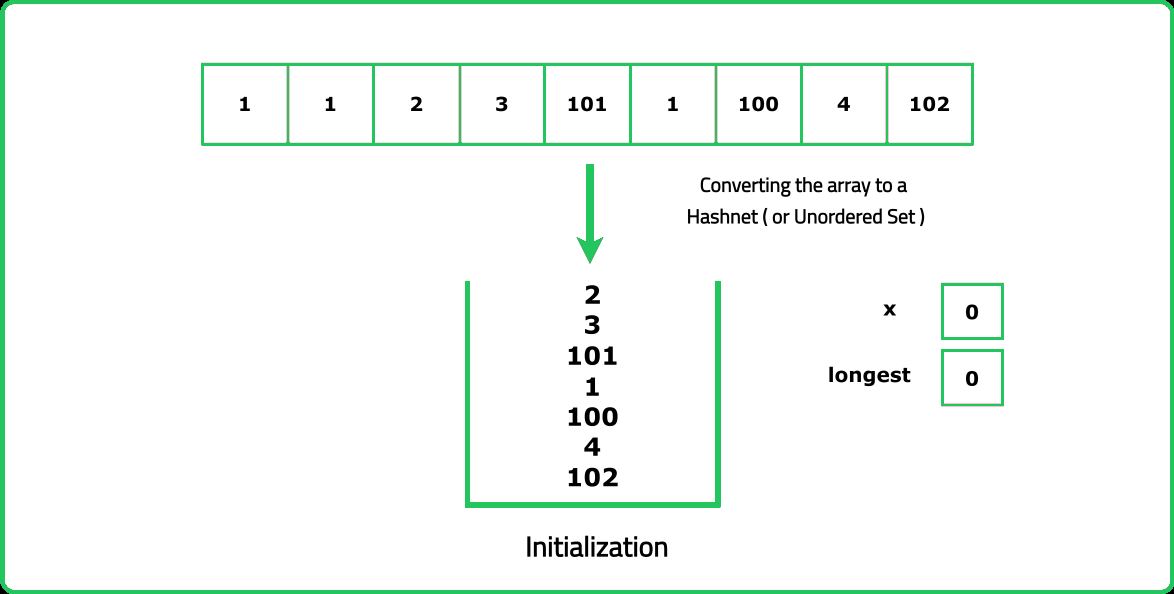
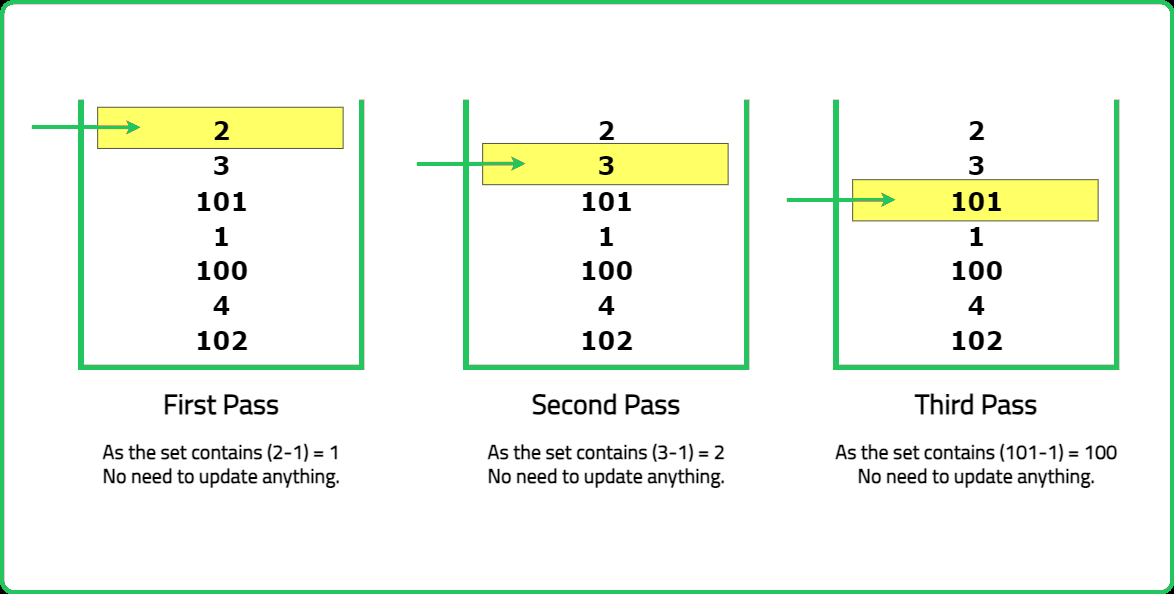
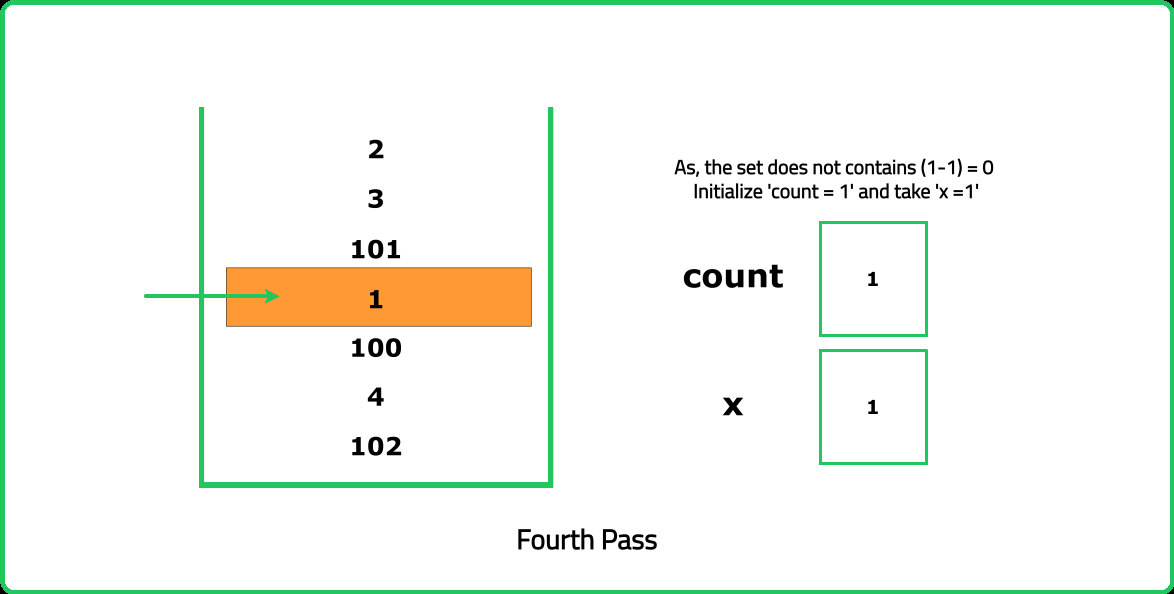
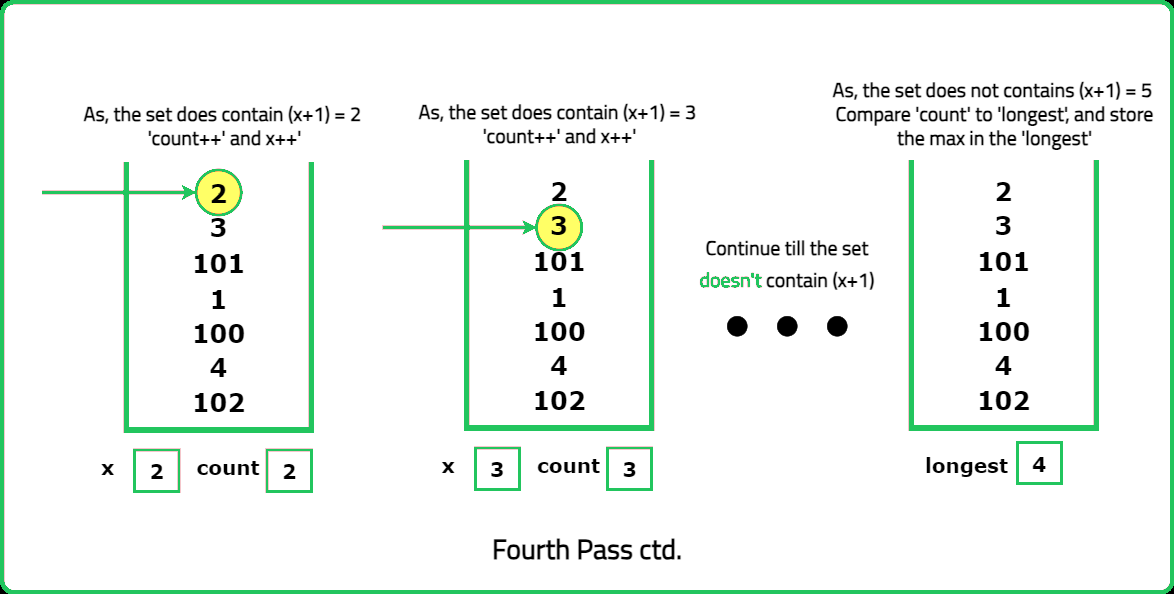
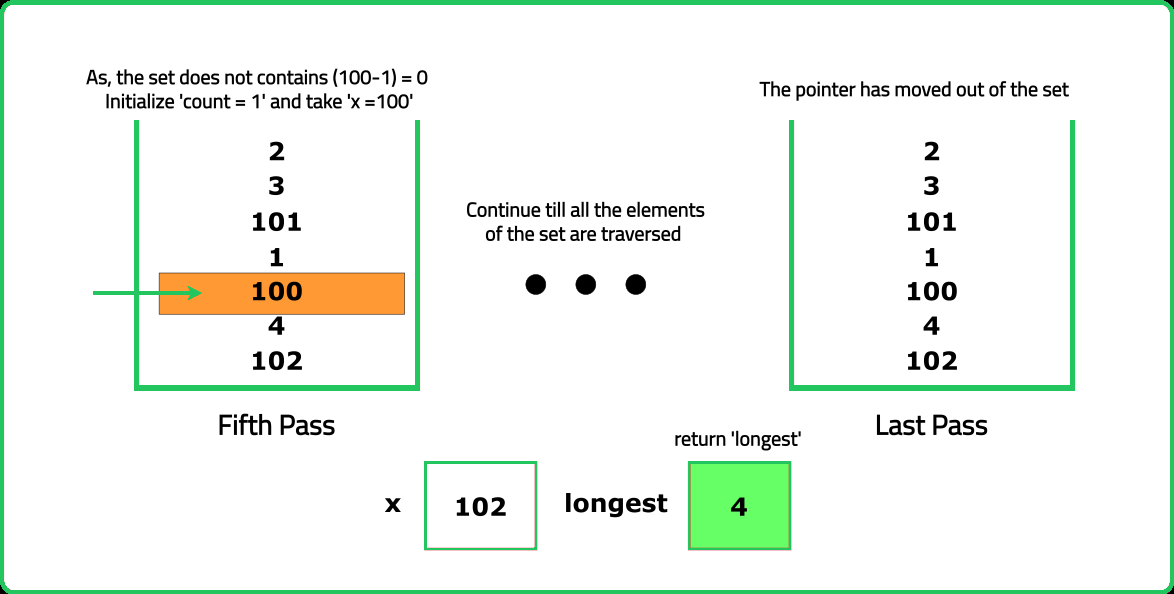





Please refer to the video for complete dry-run.
#include <bits/stdc++.h>
using namespace std;
class Solution {
public:
int longestConsecutive(vector<int>& a) {
int n = a.size();
// If the array is empty
if (n == 0) return 0;
// Initialize the longest sequence length
int longest = 1;
unordered_set<int> st;
// Put all the array elements into the set
for (int i = 0; i < n; i++) {
st.insert(a[i]);
}
/* Traverse the set to
find the longest sequence */
for (auto it : st) {
// Check if 'it' is a starting number of a sequence
if (st.find(it - 1) == st.end()) {
// Initialize the count of the current sequence
int cnt = 1;
// Starting element of the sequence
int x = it;
// Find consecutive numbers in the set
while (st.find(x + 1) != st.end()) {
// Move to the next element in the sequence
x = x + 1;
// Increment the count of the sequence
cnt = cnt + 1;
}
// Update the longest sequence length
longest = max(longest, cnt);
}
}
return longest;
}
};
int main() {
vector<int> a = {100, 4, 200, 1, 3, 2};
// Create an instance of solution class
Solution solution;
// Function call for finding longest consecutive sequence
int ans = solution.longestConsecutive(a);
cout << "The longest consecutive sequence is " << ans << "\n";
return 0;
}
import java.util.*;
class Solution {
public int longestConsecutive(int[] nums) {
int n = nums.length;
// If the array is empty
if (n == 0) return 0;
// Initialize the longest sequence length
int longest = 1;
Set<Integer> st = new HashSet<>();
// Put all the array elements into the set
for (int i = 0; i < n; i++) {
st.add(nums[i]);
}
/* Traverse the set to
find the longest sequence */
for (int it : st) {
// Check if 'it' is a starting number of a sequence
if (!st.contains(it - 1)) {
// Initialize the count of the current sequence
int cnt = 1;
// Starting element of the sequence
int x = it;
// Find consecutive numbers in the set
while (st.contains(x + 1)) {
// Move to the next element in the sequence
x = x + 1;
// Increment the count of the sequence
cnt = cnt + 1;
}
// Update the longest sequence length
longest = Math.max(longest, cnt);
}
}
return longest;
}
public static void main(String[] args) {
int[] a = {100, 4, 200, 1, 3, 2};
// Create an instance of the solution class
Solution solution = new Solution();
// Function call to find the longest consecutive sequence
int ans = solution.longestConsecutive(a);
System.out.println("The longest consecutive sequence is " + ans);
}
}
class Solution:
def longestConsecutive(self, nums):
n = len(nums)
# If the array is empty
if n == 0:
return 0
# Initialize the longest sequence length
longest = 1
st = set()
# Put all the array elements into the set
for i in range(n):
st.add(nums[i])
# Traverse the set to find the longest sequence
for it in st:
# Check if 'it' is a starting number of a sequence
if it - 1 not in st:
# Initialize the count of the current sequence
cnt = 1
# Starting element of the sequence
x = it
# Find consecutive numbers in the set
while x + 1 in st:
# Move to the next element in the sequence
x = x + 1
# Increment the count of the sequence
cnt = cnt + 1
# Update the longest sequence length
longest = max(longest, cnt)
return longest
if __name__ == "__main__":
a = [100, 4, 200, 1, 3, 2]
# Create an instance of the solution class
solution = Solution()
# Function call to find the longest consecutive sequence
ans = solution.longestConsecutive(a)
print("The longest consecutive sequence is", ans)
class Solution {
longestConsecutive(nums) {
let n = nums.length;
// If the array is empty
if (n === 0) return 0;
// Initialize the longest sequence length
let longest = 1;
let st = new Set();
// Put all the array elements into the set
for (let i = 0; i < n; i++) {
st.add(nums[i]);
}
// Traverse the set to find the longest sequence
for (let it of st) {
// Check if 'it' is a starting number of a sequence
if (!st.has(it - 1)) {
// Initialize the count of the current sequence
let cnt = 1;
// Starting element of the sequence
let x = it;
// Find consecutive numbers in the set
while (st.has(x + 1)) {
// Move to the next element in the sequence
x = x + 1;
// Increment the count of the sequence
cnt = cnt + 1;
}
// Update the longest sequence length
longest = Math.max(longest, cnt);
}
}
return longest;
}
}
// Sample array
const a = [100, 4, 200, 1, 3, 2];
// Create an instance of the solution class
const solution = new Solution();
// Function call to find the longest consecutive sequence
const ans = solution.longestConsecutive(a);
console.log("The longest consecutive sequence is " + ans);
Complexity Analysis
Time Complexity: O(N) + O(2xN) ~ O(3xN), where N is the size of the array. The function takes O(N) to insert all elements into the set data structure. After that, for every starting element, we find the consecutive elements. Although nested loops are used, the set will be traversed at most twice in the worst case. Therefore, the time complexity is O(2xN) instead of O(N2). Space Complexity: O(N), as we use a set data structure to solve this problem.Note: The time complexity assumes that we use an unordered_set, which has O(1) time complexity for set operations.
In the worst case, if the set operations take O(N), the total time complexity would be approximately O(N2). If we use a set instead of an unordered_set, the set operations will have a time complexity of O(logN), resulting in a total time complexity of O(NlogN).
Frequently Occurring Doubts
Q: Why use a hash set instead of sorting the array?
A: Using a hash set allows O(1) lookups and avoids the O(nlogn) overhead of sorting. The entire algorithm runs in O(n), making it more efficient for large arrays.
Interview Followup Questions
Q: How would you modify the algorithm to return the actual sequence instead of its length?
A: In addition to tracking the length, maintain the starting number of the longest sequence. Once identified, reconstruct the sequence by iterating from the starting number up to its length.
Notes
Code
4
9
4
Facts
- • This problem can be applied in the development of streaming multimedia platforms, for example, Netflix or YouTube
- • These platforms need to correctly sequence video packets, which could arrive out of order, to provide a seamless streaming experience
- • Understanding how to find/integrate sequences of consecutive numbers can therefore be crucial for designing the algorithms to handle this task